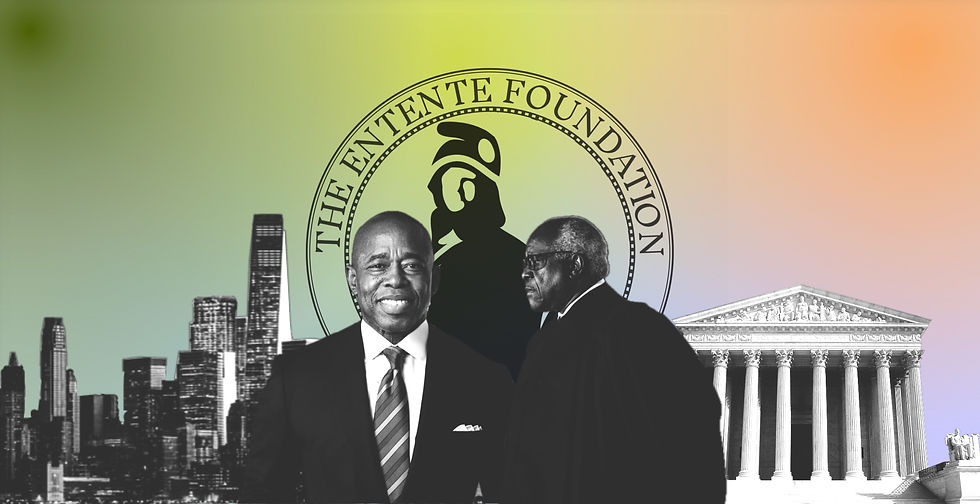Foreign assistance, Chinese rise and what USAID has to do with it
- The Entente Foundation

- Feb 19
- 3 min read
The essential to learn about American foreign aid «en pendant» the USAID scandal is more about the state of “battleground”. American agency is often mentioned as the tool for the U.S. grand strategies and policies in Africa, one the main regions for the U.S.-China competition. While the domestic tensions are still ongoing, we should have a look at the core processes behind Trump's reform. The Chinese factor stands out as the biggest concern among both conservatives and liberals in American political life: the new “Red Threat” has emerged as the bipartisan question of U.S. foreign policy since the beginning of the century. Contemporaneous tensions between Washington and Beijing revolved around partisan U.S. debates—trade deficits and China’s claims over Taiwan. Under Obama, the China question remained largely confined to Congressional discussions initiated during George W. Bush’s presidency. Obama’s policy thus systematized a response to the U.S. absence in East Asia during the 2000s (Kanidev, 2024). Nevertheless, we are in a completely different world now – to understand the major US projects abroad it’s crucial to know the basics of the competitors’ concepts. A comparative analysis of the American and Chinese systems of economic aid hinges on examining the political traditions underpinning each country's foreign policy. The core concepts of both the U.S. and China are shaped not only by their historical positions on the world stage but also by their respective economic and theoretical traditions. In particular, an interdisciplinary analysis of their approaches to economic aid is pertinent, given the connection between the established foreign policy patterns of the U.S. and the dynamically evolving approach of China. For instance, professor John Mearsheimer of the University of Chicago argues that the actions of the Chinese Communist Party should be viewed through the lens of American developmental algorithms: the U.S. merely exemplifies a behavioral scenario of a "great power" typical in international relations (Mearsheimer, 2003).
Despite contemporary methods of analyzing the Sino-American rivalry, discerning the qualitative differences between the two systems of economic aid necessitates deconstructing and examining each one independently.
United States

U.S. economic aid, theorized by Morgenthau and others, blends realist (strategic), liberal (cooperative), and constructivist (norm-building) approaches. Post-WWII, it evolved into a key foreign policy tool with diplomatic, compensatory, and strategic-ideological functions. Key programs include the Marshall Plan, Cold War initiatives, and ongoing efforts in areas like AIDS and counter-terrorism. Modern aid is categorized into humanitarian, development, military, strategic, and security assistance.
China

China transformed from a foreign aid recipient after its 1940s revolution to a donor and U.S. rival. Early aid, driven by communist ideology, supported allies with military, political, and infrastructural assistance, including projects like the Tanzam Railway. Following the Sino-Soviet split and Deng Xiaoping's reforms, China shifted to economic pragmatism, reducing aid to communist states and prioritizing mutually beneficial projects. In the 21st century, China's foreign economic policy evolved through global expansion and the "One Belt, One Road" initiative, emphasizing economic diplomacy, concessional loans, non-interference, and bilateral agreements.
Here's a clear difference:

The essence of their paths are incredibly different. American foundation ideas are the leading factor of both domestic and foreign policies of the U.S. Therefore, we still can witness the conducting of «Manifest Destiny»: every aspect of American foreign aid is based on the very interpretations of the first political pamphlets and documents. It would not be American, if it hadn’t been heavily debated — there was still much evidence for the isolationist foreign policy in Washington’s Farewell address, Federalist papers etc. Still, America’s leading role in distribution of humanitarian aid all over the world is undoubtful.
Chinese foreign aid provides a possible future perspective of American budget reforms: Beijing’s approach is rooted in the upheaval times of the Chinese government. The Communist Party was conducting its first projects during the harsh crises and even mass starvation. Thus, such kind of foreign aid initiatives that were obviously non-profitable in the medium term, formed Chinese policy straight to the modern day – China provides concessional loans, makes strictly profitable deals and keeps these processes as the certain % of their GNP.
Despite the features of the U.S. domestic tensions, even the USAID scandal should be processed through the lens of its impact on the global scale. At this time, we had a look at the forces of parties’ engaged in the competition of the foreign aid tools for the world leading network.
What do you think on the analysis above?
Tell us in the comments or join our Forum page!



Comments